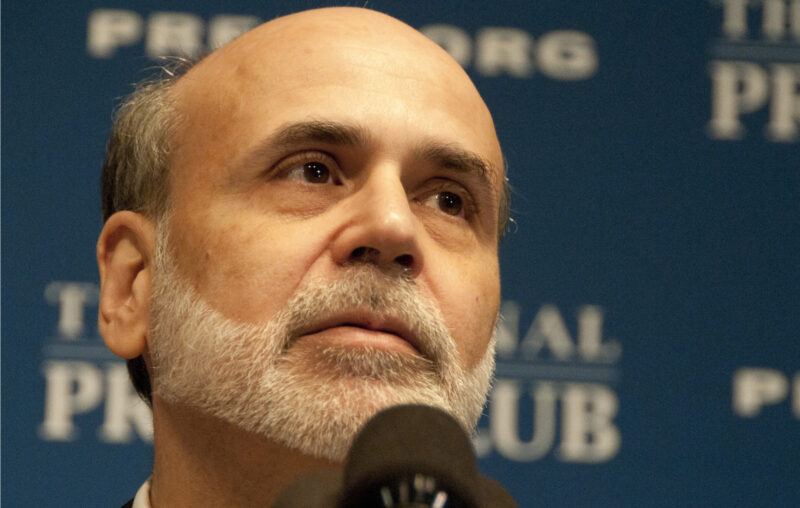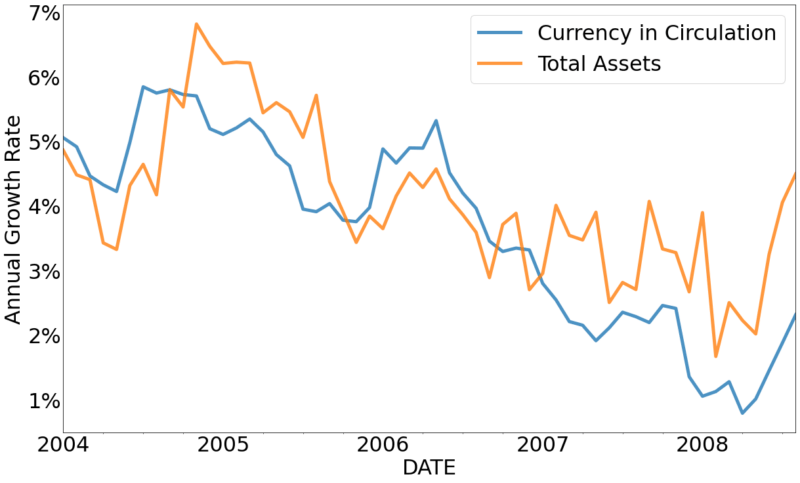Did Ben Bernanke Implement QE before the 2008 Financial Crisis?

Quantitative easing refers to the Federal Reserve’s large-scale asset purchases. The term has become a buzzword among commentators and economists over the last decade. Often forgotten in discussions about quantitative easing is that most of the funds created to make the asset purchases are not allowed to circulate in financial markets. Instead, the Federal Reserve pays banks to hold these reserves instead of lending them out.
One might expect that the net effect of quantitative easing (QE) on economic activity is neutral since the newly created money does not actually circulate in the economy. “The problem with QE,” Ben Bernanke once quipped, “is that it works in practice but it doesn’t work in theory.” While somewhat catchy, this comment does not quite reflect Bernanke’s beliefs. He believes that QE operates through a portfolio balance channel that encourages banks to reinvest funds earned from assets sold to the Federal Reserve in search of positive returns.
Concerning the effectiveness of QE, Stephen Williamson of the St. Louis Fed has opined:
Evaluating the effects of monetary policy is difficult, even in the case of conventional interest rate policy. With unconventional monetary policy, the difficulty is magnified, as the economic theory can be lacking, and there is a small amount of data available for empirical evaluation.
QE certainly played a role in preventing the collapse of financial institutions that were holding overvalued mortgages. We also know that QE impacts resource allocation. For example, the accumulation of mortgages by the Federal Reserve tends to lower mortgage rates and encourage consumers to purchase homes. It is no coincidence that the recent accumulation of mortgages by the Federal Reserve has been accompanied by a boom in the housing market.
The aggregate effect of QE on investment and total expenditures, however, is ambiguous. But this has not stopped experimentation with and widespread adoption of the policy by the Federal Reserve and central banks around the world.
Proto-QE
One form of QE has mostly gone unnoticed by academics, journalists, and financial markets commentators. Before the crisis in 2008, it appears that the Bernanke Fed had already been experimenting with quantitative easing. Jeff Hummel and John Tatom have identified the experimentation.
In 2007 and 2008, the Federal Reserve reallocated credit from the market for US Treasuries to the overnight lending market. In aggregate this looked like a divergence between the Fed’s balance sheet and circulating base currency. If we take QE to be the practice of expanding the value of Federal Reserve assets holdings without a proportional expansion in circulating currency, then we can identify proto-QE expansion where the rate of expansion of the assets side of the balance sheet is persistently greater than the rate of expansion of currency in circulation.


Divergencies in these rates are reflected by changes in the proportion of the Fed’s assets that are offset by circulating base currency. Starting in the latter half of 2006, we saw precisely this sort of change in the Federal Reserve’s balance sheet. As the federal funds rate reached a maximum just above 5 percent, something interesting changed in policy. Bernanke began to slow the rate of expansion of currency without simultaneously slowing the rate of expansion of the balance sheet. Bernanke likely imagined that he was providing liquidity to financial markets without the inflationary pressure that would accompany a proportional expansion in circulating currency.
Depending on how one measures monetary policy, one can describe it preceding the crisis as being easy or tight. Slowing the rate of expansion of currency limited upward pressure on aggregate demand, which is obviously a tightening of policy consistent with the rise in the federal funds rate target. This tight stance, with regard to currency creation, continued even as interest rates fell in response to difficulties in financial markets.
The expansion of the balance sheet was obviously intended to provide liquidity to a financial market that had begun to hiccup. If one measures the stance of monetary policy by the growth of the balance sheet, policy provided a steady level of support across much of the period. The exception here was a dip that began in 2008, but reversed as financial difficulties manifested later in the year. Add to this the reduction of the federal funds rate target beginning during 2007, and one might argue that policy had been easing for quite some time before the financial crisis began. This is perhaps why Fed officials felt like they were up against the wall.
Lingering in the background of this narrative, however, was an unwillingness of the Bernanke Fed to expand currency. It is probably not a coincidence that during 2007, Bernanke discussed his concern that short-run inflation expectations were not well-anchored. Precisely at the time that he was implementing proto-QE, he appears to have announced his motivation for such a policy.
The intended effect of this policy did not quell the financial crisis that had startled investors in the second half of 2007. Instead, the threat to the financial sector grew more extreme in September and October 2008. In a recent working paper, Proma Sen Gupta and I find that a QE-style balance sheet expansion, whether before or after October 2008, appears to slow the rate of recovery of employment and reduce upward pressure on inflation. It would be reasonable to infer from this that the impact of QE on total expenditures follows the same pattern, as nominal and real GDP never returned to trend after the crisis.
Whatever the case, commentators and policymakers would benefit from reconsidering their evaluation of pre-crisis monetary policy. The Bernanke Fed was practicing QE much earlier than is widely thought. This early QE experiment, likely intended to stabilize short-term inflation expectations, transformed monetary policy prior to the crisis. Most importantly, it failed to prevent the 2008 Financial Crisis.










